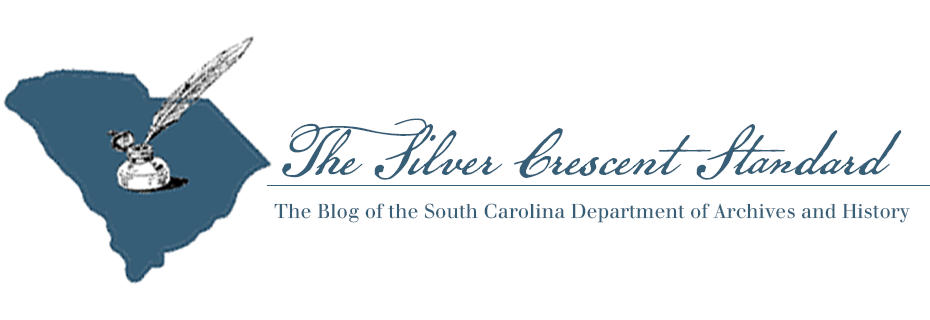
A Blog Post by John Sylvest
2021 marks 30 years since the end of the Cold War, the period of intense ideological and military competition between the United States and the Soviet Union that began after World War II and lasted until the Soviet collapse in 1991.
The term “cold war” has its roots in South Carolina. South Carolina native Bernard Baruch, a wealthy financier and advisor to multiple U.S. presidents on economic and foreign policy issues, has been credited with coining popular usage of the phrase in his April 16, 1947 speech in Columbia, South Carolina’s House of Representatives, where his portrait was being unveiled (full text of the speech from the 1947 House Journal). Journalist Herbert Bayard Swope, who wrote the speech for Baruch, is also attributed, however Baruch first used the term publicly, there after its usage was embraced by the American media and public.
South Carolina played a direct role in the manufacturing of nuclear weapons. The Department of Energy’s Savannah River Site (DOE-SRS), designed and built by DuPont between 1950 and 1956 at an incredible speed and scale, is an integral part of the DOE nuclear weapons complex. The weapons within that complex were the foundation of our nation’s military and foreign policy from the 1940s until the1990s. SRS’s role was to produce plutonium and tritium, the raw materials needed for the manufacture of nuclear and thermonuclear weapons. SRS has also played a significant role in the development of atomic energy as well as in the environmental and disarmament legacies related to the Cold War.
DOE-SRS, in consultation with the SC State Historic Preservation Office (SHPO) pursuant to Section 106 of the National Historic Preservation Act, determined that over 200 buildings and structures at the original Savannah River Plant contribute to a historic district eligible for listing in the National Register of Historic Places at the national level of significance. There were 12 properties (including 5 heavy water production reactors, 2 chemical separations facilities, the main technical laboratory, the physics laboratory, the mockup building, 2 pilot plants, and the main administration building) that were determined to be individually eligible for listing in the National Register at the national level of significance. The Site, its buildings, structures, and its layout, constitute a unique Cold War cultural landscape that is significant on a national, state, and local level in the areas of engineering, military, industry, and social history.
Many of these SRS historic properties have since been decommissioned and demolished. The thematic documentation studies that were developed as mitigation are available on our Historic Contexts webpage (under Industry related) and by request in the Research Room at the SC Archives & History Center (see S108142 finding aid, starting page 11). SRS’s excellent 50th anniversary publication, Savannah River Site at Fifty, is also available on our Historic Contexts webpage or in select libraries in South Carolina, including here at the SC Archives & History Center.
An accident involving the dangers of atomic weapons occurred in 1958 at Mars Bluff, a rural area near Florence, SC, where a US Air Force bomber accidently dropped an atomic bomb, flattening buildings and leaving a crater. Fortunately the warhead did not detonate and no one was hurt. The incident garnered national and international media coverage. Today, the site is commemorated by a state historical marker that was approved by the Department.
South Carolina also received its share of Cold War defense spending in the form of new or expanded military installations and facilities judged essential to national security. With the exception of the direct deterrent role played by the nuclear fleet of ballistic missile and attack submarines at Charleston Naval Base, the role of most of the state’s military installations was to provide for and maintain fighting forces and equipment. New or expanded major installations included:
- Charleston Naval Base, once the third largest home port and fourth largest naval base in the U.S. – the base included the Naval Shipyard, Naval Supply Center, Naval Mine Craft Base, Naval Weapons Station, and the Polaris Missile Facility, among other commands and facilities;
- Fort Jackson in Columbia, the largest Army basic training facility in the U.S.;
- Shaw Air Force Base, the home to one of two Tactical Air Control Wings in the continental U.S.;
- Charleston Air Force Base, a major air lift and tactical air transportation facility;
- Myrtle Beach Air Force Base;
- McEntire Air National Guard Base;
- Marine Corps Recruit Depot at Parris Island, which provides basic training for most of the nation’s male and female recruits; and,
- Marine Corps Air Station in Beaufort.
An excellent resource which provides contextual background and an inventory of the Cold War Department of Defense resources in SC is The Cold War in South Carolina, 1945-1991: An Inventory of Department of Defense Cold War Era Cultural and Historical Resources in the State of South Carolina, 4 Vols., (1995), conducted by the University of South Carolina Legacy Project.
Another report available is the Navy Cold War Guided Missile Context: Resources Associated with the Navy’s Guided Missile Program, 1946-1989, (1995), conducted by R. Christopher Goodwin and Associates, Inc. Charleston’s Polaris Missile Facility (POMFLANT) is discussed in the report.
These two reports are a part of our statewide survey of historic properties collection, which is available by request in the Research Room at the SC Archives & History Center (see S108042 Thematic Studies finding aid, page 12 for more information; see our Survey webpage for the collection’s entire finding aid).
Due to the Cold War, South Carolina gained new population groups and increased defense, economic, educational, and transportation activity. South Carolina played a direct and vital role in the nation’s deterrence task.
For additional information:
SRS Cold War Historic Preservation
Savannah River Site Heritage Foundation Museum
Savannah River Archaeological Research Program, Former Towns
